
Welcome to arlingtonsnakes.com! I am David, a snake enthusiast living in Arlington, VA. Many people don't know that Arlington is in fact full of snakes! You just need to know where to find them - they can often be shy and elusive. Some Virginia snake species are more common outside of the city limits, in different parts of Arlington County VA, but many types of snakes are indeed common in the more urban parts of Arlington. This guide is meant to help educate you about the beautiful snakes of Arlington, and to help you identify the most common snakes of Arlington, as well as the venomous snakes of Arlington that you should learn to recognize and avoid. If you want more detail, click here for my complete list of ALL snake species in Arlington. Remember the following:
- Most snakes of Arlington are harmless and don't want to encounter you
- Venomous snakes exist but are uncommon in Arlington, Virginia
- Snakes eat rats and mice and are a valuable part of the Virginia ecosystem
- Never kill a snake - if you leave a snake alone, it will leave you alone.
Common Snake Species in Arlington
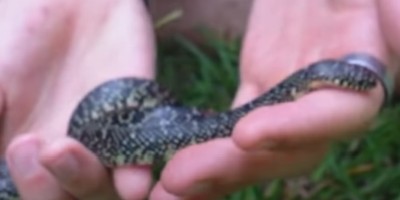 Common kingsnake:
Also known as the eastern kingsnake, these snakes are mostly black with white or pale yellow narrow bands alternating across their bodies. These snakes are very common in Arlington and are mostly found in streams, ponds, waterways, and wetlands. On average, these snakes measure from 20 to 48 inches.
Common kingsnake:
Also known as the eastern kingsnake, these snakes are mostly black with white or pale yellow narrow bands alternating across their bodies. These snakes are very common in Arlington and are mostly found in streams, ponds, waterways, and wetlands. On average, these snakes measure from 20 to 48 inches.
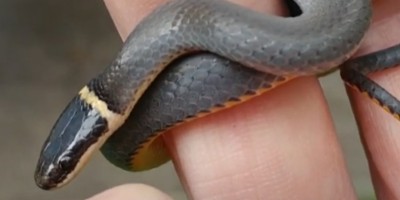 Northern ring-neck snake:
This is a small black or gray snake with a vivid yellowish orange ring around its neck. These snakes are common in forests and residential neighborhoods in Arlington. They are usually about 11 to 15 inches long with slightly venomous saliva, but they rarely bite and are harmless to humans.
Northern ring-neck snake:
This is a small black or gray snake with a vivid yellowish orange ring around its neck. These snakes are common in forests and residential neighborhoods in Arlington. They are usually about 11 to 15 inches long with slightly venomous saliva, but they rarely bite and are harmless to humans.
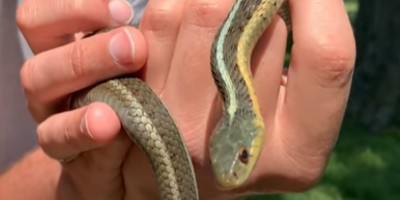 Eastern garter snake:
This is one of the most common snakes in Arlington County. They are commonly found near wetland habitats and sometimes in suburbs. These snakes can be green or brown with bold yellow or white stripes along their bodies, with a cream-colored belly and their average size is 20 to 28 inches.
Eastern garter snake:
This is one of the most common snakes in Arlington County. They are commonly found near wetland habitats and sometimes in suburbs. These snakes can be green or brown with bold yellow or white stripes along their bodies, with a cream-colored belly and their average size is 20 to 28 inches.
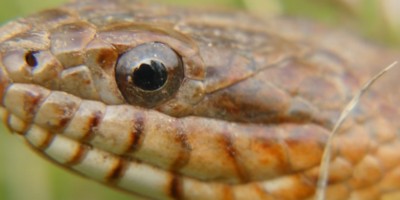 Northern water snake:
These are dark-colored water snakes with even darker square bands across their bodies, they are non-venomous and are found mostly around wet habitats. The length of this snake ranges from 24 to 55 inches. Northern water snakes are sometimes mistaken as the venomous water moccasin. Although they are non-venomous, they will bite if threatened.
Northern water snake:
These are dark-colored water snakes with even darker square bands across their bodies, they are non-venomous and are found mostly around wet habitats. The length of this snake ranges from 24 to 55 inches. Northern water snakes are sometimes mistaken as the venomous water moccasin. Although they are non-venomous, they will bite if threatened.
 Eastern hog-nosed snake:
A non-venomous pale to dark-colored snake with large brown rectangular blotches and a distinctive upturned snout. Once a common snake, the eastern hog-nosed snake is now considered an extirpated species in Arlington County due to loss of habitat.
Eastern hog-nosed snake:
A non-venomous pale to dark-colored snake with large brown rectangular blotches and a distinctive upturned snout. Once a common snake, the eastern hog-nosed snake is now considered an extirpated species in Arlington County due to loss of habitat.
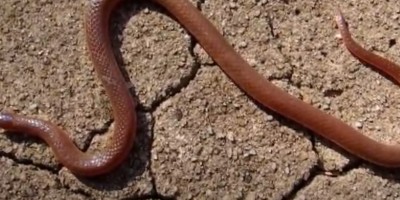 Eastern worm snake:
This is a small shiny brown snake with smooth scales and an average length of 13 inches. These snakes are fairly common in Arlington and can be encountered in forests beneath leaf piles, logs, or rocks, they are harmless and feed exclusively on earthworms.
Eastern worm snake:
This is a small shiny brown snake with smooth scales and an average length of 13 inches. These snakes are fairly common in Arlington and can be encountered in forests beneath leaf piles, logs, or rocks, they are harmless and feed exclusively on earthworms.
 Northern brown snake:
This is one of the most common snakes in Arlington County. It’s a small brown, gray, or tan snake with a light brown central stripe with rows of dark spots on each side. These snakes can be found beneath rocks or flat stones in residential backyards or in woodlands under logs or piles of moist leaves. Northern brown snakes can be anywhere between 8 and 15 inches long.
Northern brown snake:
This is one of the most common snakes in Arlington County. It’s a small brown, gray, or tan snake with a light brown central stripe with rows of dark spots on each side. These snakes can be found beneath rocks or flat stones in residential backyards or in woodlands under logs or piles of moist leaves. Northern brown snakes can be anywhere between 8 and 15 inches long.
 Northern rough green snake:
This is a slender snake with a pale green upper body and a white or pale yellow underbelly. They can be found in vines, bushes, shrubs, and low-hanging branches of trees near water bodies. The northern rough green snake can grow to about 22 to 32 inches long, they are currently not very common in Arlington.
Northern rough green snake:
This is a slender snake with a pale green upper body and a white or pale yellow underbelly. They can be found in vines, bushes, shrubs, and low-hanging branches of trees near water bodies. The northern rough green snake can grow to about 22 to 32 inches long, they are currently not very common in Arlington.
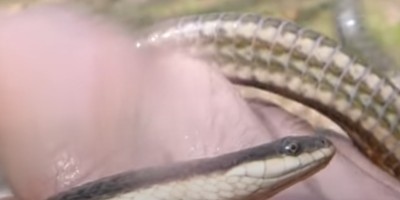 Queen snake:
The queen snake is one of the most common snakes in Arlington County. These plain brown, black, or greenish-brown snakes are often seen in terrestrial habitats outside commercially developed areas. They usually grow to a maximum length of 25 inches.
Queen snake:
The queen snake is one of the most common snakes in Arlington County. These plain brown, black, or greenish-brown snakes are often seen in terrestrial habitats outside commercially developed areas. They usually grow to a maximum length of 25 inches.
 Common ribbon snake:
A close relative of the garter snake, the ribbon snake is a small to mid-sized snake with a brown or black body and bright yellow or cream-colored stripes along their backs. These snakes will measure from 17 to 26 inches and mainly reside in wetlands.
Common ribbon snake:
A close relative of the garter snake, the ribbon snake is a small to mid-sized snake with a brown or black body and bright yellow or cream-colored stripes along their backs. These snakes will measure from 17 to 26 inches and mainly reside in wetlands.
Venomous Snake Species in Arlington
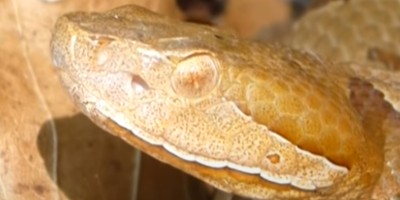 Northern copperhead:
The northern copperhead is the only venomous snake found in Arlington, Virginia. These snakes grow to about 20 to 40 inches in length and their stout bodies are usually tan or light brown with dark brown cross-bands. These snakes will bite if threatened but unlike rattlesnakes, they do not give a warning before they strike.
Northern copperhead:
The northern copperhead is the only venomous snake found in Arlington, Virginia. These snakes grow to about 20 to 40 inches in length and their stout bodies are usually tan or light brown with dark brown cross-bands. These snakes will bite if threatened but unlike rattlesnakes, they do not give a warning before they strike.If you're unsure, you can email me a photo of the snake at info@arlingtonsnakes.com and I will email you back with the snake's species. If you found a snake skin, read my Found a Skin? page, and you can email me a photo of the skin, and I'll identify the snake for you. If you need professional Arlington snake removal help, click my Get Help page, or see the below website sponsor I found, who provides that service.
Remember, the term is not poisonous snakes of Arlington, it's venomous snakes of Arlington. Poison is generally something you eat, and venom is injected into you. That said, dangerous snakes are very rare in Arlington. The few venomous snakes of Arlington County are rarely seen. But they are commonly misidentified, so learn about all the snake species of Arlington in order to correctly identify them. These snakes are usually also found in the surrounding towns of Pentagon City, Arlington Ridge, Halls Hill, Arlington Village, Lacey Forest, Brandon Village, Shirlington, Lee Heights, Aurora Hills, Williamsburg Village, Crescent Hills, South Arlington, Virginia Heights, Dominion Heights, Brockwood, Radnor Heights, Bon Air, Arna Valley, Fort Barnard Heights, Crystal Spring Knolls, Millburn Terrace, Allencrest, Country Club Manor, Arlingwood, and the surrounding areas.
Read our article about:
Are Ammonia and Mothballs Effective in Repelling Snakes?
arlingtonsnakes.com domain and hosting costs made possible by the generous support of this sponsor:
